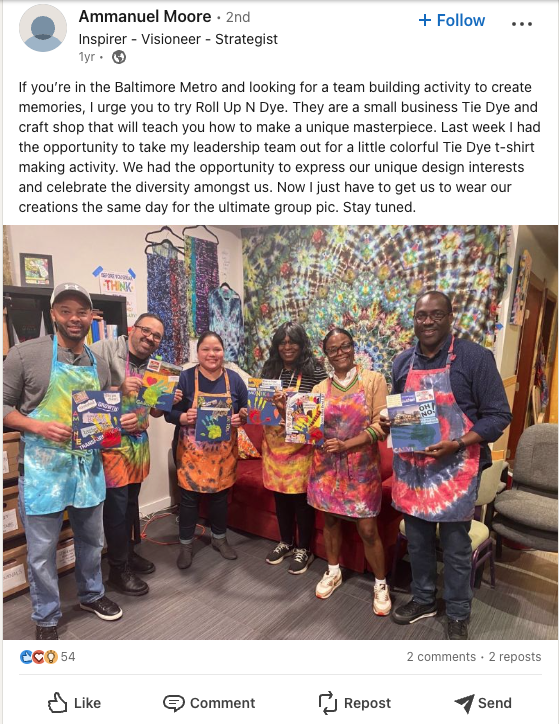Grow Your Program
How to Market Your Arts Classes to Professionals With Education Stipends

CourseStorm’s new State of the Arts Report found that 129 million adults in the U.S. — more than half of those surveyed — created and/or performed art during the previous year. Did you know that some lucky people get to do that on their company’s dime? It’s true! CourseStorm is among the growing number of companies offering education stipends as part of their benefits package.
More companies are offering education stipends to employees. These benefits may cover the arts or adult ed classes your program offers.
CourseStorm employees can use their annual educational stipend to invest in any resource that helps them learn something new. And it doesn’t have to be related to their job. Our team members have used their education stipend to subscribe to Masterclass and National Geographic, to take fitness and parenting classes, to buy books on computer science and mushroom foraging, and to sign up for stained glass workshops and ukulele lessons.
Is this the reason CourseStorm has been named one of the Best Places to Work in Maine for two years in a row? Likely so! But this article isn’t about us. It’s about how your arts or adult ed program can serve professionals who may be looking to spend their education stipend on the classes you offer. Read on to learn how to reach this customer segment you may be overlooking and grow enrollments and revenue.
What’s an Education Stipend and What Does it Cover?
To tap into this high-potential group of customers, it’s helpful to understand what stipends are, who offers them, and what they do and don’t cover. That way, you can target your outreach in a way that makes the most sense for the classes you offer. Compt, an employee stipend software company, put together a roundup of 63 examples of employee stipends at top companies. They include accounting firm Deloitte’s $500 annual well-being subsidy as well as the developer of the dating app Hinge, which offers employees a $100/month date stipend.
Visit the benefits page of top employers’ websites in your area to find out what types of employee stipends they offer.
If you have large or popular employers in your area, it may be worth visiting the benefits page on their websites to find out if they offer employee stipends and what they cover. Here are some benefits they might offer:
- Education stipend
- Professional development stipend
- Personal development stipend
- Continued learning stipend
- Well-being subsidy
- Wellness allowance
- Health & wellness subsidy
All employee stipends are not created equal. LinkedIn’s $5,000 annual education stipend is intended for tuition reimbursement for degree-granting higher education institutions. Some stipends are specifically earmarked for professional development related to a person’s job, or for commuting, home office, or childcare expenses. But plenty of other stipends are more open-ended. And that’s where your program comes in.
Classes to Market to Employees With Education Stipends
Speaking of employee benefits, flexible spending accounts (FSA) for health care expenses are a popular perk, but many people lose out on these funds by failing to spend them before they expire. Never underestimate the power of “use it or lose it” to motivate someone to take action. With the right marketing, you can position your classes as a great way for employees to use their education stipend before it expires.
This could mean speaking directly to professional learners on your website, social media, or email newsletter. Or you can do targeted outreach to specific employers in your community. Here are a few ideas for classes that may be covered by employee stipends.
Wellness-related classes. If your program offers yoga or dance classes for adults, that’s a no-brainer to pitch to people with health and wellness stipends. But many cover meditation and mindfulness-related offerings, too. Art therapy is its own specific discipline offered by licensed therapists, while mindfulness art is a broader category that doesn’t require a certified practitioner.
Do you offer any classes that could be considered mindful art? This article shares 20 examples of mindfulness art activities, including Zentangle art and splatter painting with essential oils. The benefits of art on mental and physical health are well documented, so it’s not much of a stretch to see how a wellness subsidy could cover most any art class.
Many arts organizations offer couples classes — a smart marketing strategy, since you’re getting two registrations at one time.
Couples classes. Remember Hinge’s “date night stipend” mentioned above? Even if a company doesn’t offer that specific benefit, other stipends could be used for this purpose, like a “learn something new” stipend. Many arts organizations offer couples classes. For example, CourseStorm customer Studio Arts Boulder offers popular pottery class date nights: “Bring a Bestie, your BAE, or even your Baba for a night of creating.” Couples classes are a smart marketing strategy, since you’re getting two registrations at one time.
Arts instruction. This is the most straightforward option for targeting people with education stipends that cover any type of instruction related to learning something new. Music lessons, watercolor classes, jewelry making workshops, woodworking courses, knitting classes — all of these would qualify for most personal development education stipends.

Other Ways to Market Your Arts and Enrichment Classes to Professional Audiences
In addition to encouraging employees to spend their stipends on your classes, there are other ways to tap into this valuable segment of customers. You can market your offerings to appeal to both employers and employees. For example, classes can be positioned as:
- Team building activities – suggest a metalworking workshop in lieu of golf outings or escape rooms
- Customer appreciation perks – businesses can give their best customers gift cards for classes or tickets to performances
- Professional development of soft skills – improv classes to build collaboration and public speaking skills; art classes to develop creativity, etc.)
- Personal enrichment – employees (and employers!) are people, too, and many will be interested in your offerings for their own interest and enjoyment, whether their employer is subsidizing it or they’re paying for it themselves
You may be wondering where to advertise and promote your arts and enrichment classes to a professional audience. While our data show that Facebook is the most popular social media platform for promoting classes among our arts customers, LinkedIn is used by more than 1 billion professionals and companies. You might test out both platforms and see what works for your program.
Offer the Features Corporate Customers Need
If you’re marketing your classes to professional groups or corporate customers, you’ll need to provide a professional experience. These customers will likely require:
- Group registration, so they can sign up an entire team or department
- The ability to pay online, e.g., on a corporate credit card
- Receipts for accounting and reimbursement purposes
- Clear followup messaging – say, email confirmations to all participants and perhaps suggestions for what to wear, what to bring to class, etc.
You can manually provide most of these things, or cobble them together from free tools like Google Forms. But if you want to present a modernized, professional experience that encourages word-of-mouth referrals to other businesses, consider investing in class registration software like CourseStorm that has those automated features built in.
To learn more about how to grow your arts education program with new audiences, check out our article on partnering with local businesses to reach more students.

Abigail Green
Abby has overseen content development for higher education degree programs related to education, technology, business, and healthcare. One of her first jobs after college was working with children’s programs for the Walters Art Museum in Baltimore, Maryland. She is an experienced and versatile writer and editor whose work has been published by Johns Hopkins, the University of Baltimore Alumni Magazine, and The Chicago Tribune.
